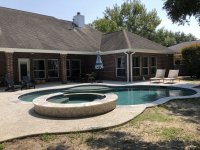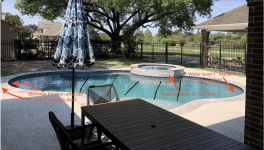We had a new in-ground/gunite pool installed in July 2022. (The depth is 3.5', 5', 3.5' with attached spa, approx 15,500 gallons, chlorine). Last month, December 2022, we noticed some concerning issues developing with our pool, and contacted our pool contractor right away. The water level has become uneven across the pool, to the point that there is now a 1" difference in the water level from one side of the pool to the other. This has caused our spa spillway to spill unevenly over to one side, and is also affecting the functioning of the skimmer on the "low water" end of the pool. Further, a 6' crack has developed in the concrete/pool deck on this same side. Most recently, the vacuum has failed. Whenever we try to run the vacuum, it pulls air into the pump, so our best guess is that the shifting of the pool has caused the vacuum line to crack underneath the ground. A month later and our pool contractor is still dragging their feet to get these issues resolved. They finally sent someone out yesterday to take a look at the pool, and his solution was to give it time and keep an eye on it for any further shifting. We told him this was not acceptable, and that the issues needed to be addressed immediately, although I have little confidence of this happening. Our contract states that the contractor guarantees all materials and workmanship for one year after the pool is plastered (which was in July 2022), plus an additional lifetime warranty on the gunite.
Has anyone had a similar experience with a new gunite pool? What is the best way to fix this issue? From what I have read online, the best solution seems to be installing helical piers/piles under the pool, however I was hoping to get advice from someone more knowledgeable on the subject. Will this lift the pool back to the proper depth, or will it simply prevent further shifting? What is an acceptable solution for the pool company to offer at this point??? Thanks for any advice you can provide!


Has anyone had a similar experience with a new gunite pool? What is the best way to fix this issue? From what I have read online, the best solution seems to be installing helical piers/piles under the pool, however I was hoping to get advice from someone more knowledgeable on the subject. Will this lift the pool back to the proper depth, or will it simply prevent further shifting? What is an acceptable solution for the pool company to offer at this point??? Thanks for any advice you can provide!


Last edited by a moderator:



